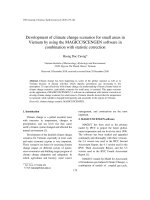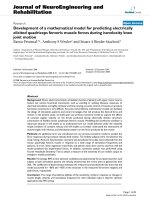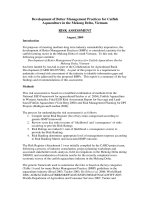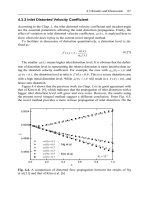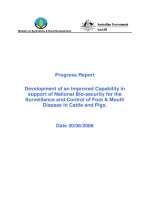Development of p y criterion for anisotropic rock and cohesive intermediate geomaterials
Bạn đang xem bản rút gọn của tài liệu. Xem và tải ngay bản đầy đủ của tài liệu tại đây (3.94 MB, 241 trang )
DEVELOPMENT OF P-Y CRITERION FOR ANISOTROPIC ROCK AND
COHESIVE INTERMEDIATE GEOMATERIALS
A Dissertation
Presented to
The Graduate Faculty of the University of Akron
In Partial Fulfillment
of the Requirements for the Degree
Doctor of Philosophy
Ehab Salem Shatnawi
August, 2008
DEVELOPMENT OF P-Y CRITERION FOR ANISOTROPIC ROCK AND
COHESIVE INTERMEDIATE GEOMATERIALS
Ehab Salem Shatnawi
Dissertation
Approved:
Accepted:
______________________________
Advisor
Dr. Robert Liang
______________________________
Department Chair
Dr. Wieslaw Binienda
______________________________
Committee Member
Dr. Craig Menzemer
______________________________
Dean of the College
Dr. George K. Haritos
______________________________
Committee Member
Dr. Daren Zywicki
______________________________
Dean of the Graduate School
Dr. George R. Newkome
______________________________
Committee Member
Dr. Xiaosheng Gao
______________________________
Date
______________________________
Committee Member
Dr. Kevin Kreider
ii
ABSTRACT
Rock-socketed drilled shaft foundations are commonly used to resist large axial and
lateral loads applied to structures or as a means to stabilize an unstable slope with either
marginal factor of safety or experiencing continuing slope movements. One of the widely
used approaches for analyzing the response of drilled shafts under lateral loads is the p-y
approach. Although there are past and ongoing research efforts to develop pertinent p-y
criterion for the laterally loaded rock-socketed drilled shafts, most of these p-y curves
were derived from basic assumptions that the rock mass behaves as an isotropic
continuum. The assumption of isotropy may not be applicable to the rock mass with
intrinsic anisotropy or the rock formation with distinguishing joints and bedding planes.
Therefore, there is a need to develop a p-y curve criterion that can take into account the
effects of rock anisotropy on the p-y curve of laterally loaded drilled shafts.
A hyperbolic non-linear p-y criterion for rock mass that exhibit distinguished
transverse isotropy is developed in this study based on both theoretical derivations and
numerical (finite element) parametric analysis results. Evaluations based on parametric
study on full-scale lateral load test on fully instrumented drilled shaft have shown the
insights on the influences of rock anisotropy on the predicted response of the rock
socketed drilled shaft under the lateral load. Both, the orientation of the plane of
transversely isotropy, and the degree of anisotropy (E/E’) has influences on the main two
iii
parameters required to characterize the p-y curve, the subgrade modulus (Ki) and the
ultimate lateral resistance (pu).
In addition to the development of a hyperbolic p-y criterion of transversely isotropic
rock, another p-y criterion for cohesive intermediate geomaterials (IGM) using
hyperbolic mathematical formulation is developed herein by employing the results of a
series of finite element (FE) simulations and the results of two full scale lateral load test
for drilled shaft socketed into IGM.
iv
DEDICATION
To my mother, my father, my wife, my sisters and brothers, my friends, and to anyone
who would read this dissertation. Also, I would like to dedicate this work to my expected
baby.
v
ACKNOWLEDGEMENTS
All praise is due to Allah (S.W.T) without whom nothing
good of this work can be ever accomplished.
Though only my name appears on the cover of this
dissertation, a great many people have contributed to its
production. I owe my gratitude to all those people who have
made this dissertation possible and because of whom my
graduate experience has been one that I will cherish forever.
My deepest gratitude is to my advisor, Dr. Robert Liang. I
have been amazingly fortunate to have an advisor who gave me
the freedom to explore on my own and at the same time the
guidance to recover when my steps faltered. I hope that one day
I would become as good an advisor to my students as Prof.
Robert Liang has been to me.
Also of a great importance are the help and constructive
comments and contributions I received from my committee
members, Dr. Craig Menzemer, Dr. Daren Zywicki, Dr. YuehJaw Lin, Dr. Xiaosheng Gao and Dr. Kevin Kreider. I would
also like to acknowledge the support I received from personnel in
our department, particularly Mrs. Kimberly Stone and Mrs.
Christina.
I must acknowledge as well the many friends, and colleagues,
who assisted, advised, and supported me during these three and a
vi
half year. Especially, I need to express my gratitude and deep
appreciation to my former roommate, Dr. Mohammad Yamin,
whose friendship, knowledge, and wisdom have supported,
enlightened, and entertained me over the ten years of our
friendship. I must also acknowledge my former advisor, Dr.
Abdulla Malkawi, I have learned so much from his keen insight,
his research and problem solving abilities, and his amazing
energy.
Special thanks also to Dr. Jamal Nusairat, Dr. Diya Azzam,
Dr. Inmar Badwan, Dr. Firas Hasan, Dr. Sami Khorbatli, Dr.
Samer Rababa’a, Dr. Khalid Alakhras, Dr. Wael Khasawneh,
Dr. Mohammad Khasawneh, Dr. Qais Khasawneh, Saleh
Khasawneh, Abdallah Sharo, Wassel Bdour, Madhar Tamneh,
Mohannad Aljarrah, Khalid Elhindi, Jamal Tahat, Khalid
Mustafa, and my friends in Jordan, Eng. Kifah Ewisat, Eng.
Mamoun Shatnawi, Eng. Mohammad Al-sakran, and Eng.
Sameer Mousa. They have consistently helped me keep
perspective on what is important in life and shown me how to
deal with reality.
Most importantly, none of this would have been possible
without the love and patience of my family. My parents (Salem
and Salmeh), my darling and lovely wife SAHAR, my sisters
(Heba, Ruba, Waed, and the little and lovely one Lina) and
brothers (Dr. Mohammad, Abdulla, Hussain, Dr. Murad, and
Moad) to whom this dissertation is dedicated to, has been a
constant source of love, concern, support and strength all these
years. I would like to express my heart-felt gratitude to them.
vii
TABLE OF CONTENTS
Page
LIST OF TABLES.......................................................................................................... xiii
LIST OF FIGURES .........................................................................................................xiv
CHAPTER
I. INTRODUCTION .........................................................................................................1
1.1 Statement of Problem ............................................................................................1
1.2 Objectives ..............................................................................................................8
1.3 Work Plan ..............................................................................................................9
1.4 Dissertation Outlines ...........................................................................................13
II. LITERATURE REVIEW...........................................................................................15
2.1 Analysis Methods of Laterally Loaded Rock-Socketed Drilled Shafts...............15
2.1.1 Elastic continuum methods........................................................................16
2.1.2 Winkler Method (Subgrade reaction approach) and P-Y method .............17
2.2 Analysis Methods for Estimating Ultimate Lateral Rock Reaction ....................22
2.2.1 Carter and Kulhawy (1992) .......................................................................24
2.2.2 Zhang et al. (2000) ....................................................................................25
2.2.3 To, Ernst, and Einstein (2003)...................................................................26
2.2.4 Yang (2006)...............................................................................................27
2.3 Initial Modulus of Subgrade Reaction.................................................................30
2.4 Ultimate Side Shear Resistance ...........................................................................32
viii
2.5 Discussion of Analytical Models for Laterally Loaded Sockets .........................35
2.6 Bedrocks ..............................................................................................................38
2.6.1 Rocks in Ohio ............................................................................................38
2.6.2 Rock Characterization ...............................................................................39
2.6.3 Rock Categories.........................................................................................40
2.7 Laboratory and In-situ testing for Transversely Isotropic Rock..........................44
III. TRANSVERSE ISOTROPY EFFECTS ON THE INITIAL TANGENT TO P-Y
CURVE .............................................................................................................................49
3.1 Abstract................................................................................................................49
3.2 Introduction..........................................................................................................50
3.3 Sensitivity Analysis .............................................................................................51
3.4 FE Analysis..........................................................................................................54
3.4.1 Description of FE Model ...........................................................................54
3.4.2 Constitutive Models...................................................................................55
3.4.3 FE Analysis ...............................................................................................56
3.4.4 FE Parametric Study Results .....................................................................57
3.5 Estimating the Transversely Isotropic Parameters ..............................................65
3.6 Sensitivity of the Transversely Isotropic Parameters ..........................................70
3.7 Summary and Conclusions ..................................................................................76
IV. TRANSVERSELY ISOTROPIC EQUIVALENT MODEL FOR JOINTED
ROCK ...............................................................................................................................78
4.1 Abstract................................................................................................................78
4.2 Introduction..........................................................................................................78
4.3 Literature Review ................................................................................................80
4.4 Equivalent Homogeneous Model ........................................................................82
4.4.1 Summary....................................................................................................94
ix
4.4.2 Model Verification ....................................................................................96
4.5 Summary and Conclusions ..................................................................................97
V. ULTIMATE SIDE SHEAR RESISTANCE OF ROCK-SOCKETED DRILLED
SHAFT..............................................................................................................................99
5.1 Abstract................................................................................................................99
5.2 Introduction........................................................................................................100
5.3 Theoretical model, fundamental interface behavior ..........................................103
5.4 FE Study ............................................................................................................104
5.4.1 3-D FE Modelling....................................................................................104
5.4.2 Constitutive Models.................................................................................105
5.4.3 FE Analysis Simulation...........................................................................106
5.5 Factors affecting the ultimate side shear resistance...........................................108
5.5.1 Effect of Rock Mass Properties (Em, Cr, Фr) ...........................................109
5.5.2 Effect of Drilled Shaft Geometry and Shear Modulus ............................110
5.6 Suggested Empirical Relationships ...................................................................115
5.7 Validation of the Empirical Equation ................................................................117
5.8 Summary and Conclusions ................................................................................119
VI. ULTIMATE LATERAL RESISTANCE OF TRANSVERSELY ISOTROPIC
ROCK .............................................................................................................................124
6.1 Abstract..............................................................................................................124
6.2 Introduction........................................................................................................125
6.3 Rock Failure at Shallow Depth..........................................................................127
6.3.1 Derivation of pu at shallow depth ............................................................130
6.3.2 FE Parametric Study Results ...................................................................133
6.4 Rock Failure at the Great Depth ........................................................................139
6.5 Strength of Transversely Isotropic Rock ...........................................................143
x
6.6 Illustrative Example...........................................................................................146
6.7 Summary and Conclusions ................................................................................149
VII. HYPERBOLIC P-Y CRITERION FOR TRANSVERSELY ISOTROPIC
ROCK .............................................................................................................................152
7.1 Introduction........................................................................................................152
7.2 General Shape of P-y Curve in Rock.................................................................153
7.3 Construction of P-y curves for transversely isotropic rock ...............................154
7.4 Sensitivity Analysis ...........................................................................................156
7.5 Predicting Dayton Test Results .........................................................................162
7.6 Illustrative Example...........................................................................................164
7.7 Summary and Conclusions ................................................................................167
VIII. HYPERBOLIC P-Y CRITERION FOR COHESIVE INTERMEDIATE
GEOMATERIAL............................................................................................................169
8.1 Introduction........................................................................................................169
8.2 Background........................................................................................................169
8.3 Documentation of Two Lateral Load Tests and Results ...................................171
8.3.1 Lateral Load Test at JEF-152-1.3 ...........................................................171
8.3.2 Lateral Load Test at War-48-2102 (Warren County, Ohio)....................179
8.4 Literature Review ..............................................................................................186
8.4.1 Initial Tangent to p-y Curve ....................................................................186
8.4.2 Ultimate Resistance, Pult ..........................................................................187
8.5 FE Modeling ......................................................................................................188
8.5.1 Initial Tangent to p-y curve, Ki ...............................................................188
8.5.2 Ultimate Lateral Resistance, Pult ..............................................................190
8.6 Case Studies.......................................................................................................194
8.6.1 Ohio JEF-152 Test...................................................................................194
xi
8.6.2 Ohio WAR-48 Test..................................................................................195
8.6.3 Ohio LOR-6 Test (Liang, 1997) ..............................................................195
8.6.4 Salt Lake International Airport Test (Rollins et al, 1998).......................196
8.6.5 Ohio CUY-90 Test (Liang, 2000) ...........................................................197
8.6.6 Colorado I-225 Test (Nusairat, et al, 2004).............................................197
8.7 Summary and Conclusions ................................................................................198
IX. SUMMARY AND CONCLUSIONS .....................................................................210
9.1 Summary............................................................................................................210
9.2 Conclusions........................................................................................................212
9.3 Recommendations for Future Studies................................................................213
REFERENCES ...............................................................................................................215
xii
LIST OF TABLES
Table
Page
2-1 Summary of the design methods of ultimate resistance predictions ......................... 34
3-1 Input Rock Mass Parameters of I-40 Load Test ......................................................... 53
3-2 Parameters variation for the FEA .............................................................................. 58
3-3 Sensitivity analysis of Ki (Stage I) ............................................................................. 63
3-5 Effect of β on Ki ........................................................................................................ 72
3-6 Effect of rock anisotropy on Ki ................................................................................. 72
5-1 Range of model parameters for the FE parametric study ........................................ 107
5-3 Input data for the proposed equation estimated using the
information given in Table 5-2 ....................................................................................... 122
5-4 Side shear resistance of drilled shafts,
a comparison of experimental values and those predicted by empirical equations ........ 123
6-1 Parameters variation for the FE study ...................................................................... 134
6-2 Sensitivity analysis of CF (Stage I) .......................................................................... 136
7-1 Effect of anisotropy on the p-y curve parameters..................................................... 157
8-1 Pressuremeter Test Results...................................................................................... 173
8-2 Laboratory Test results ............................................................................................. 173
8-3 Dilatometer Test Results .......................................................................................... 179
8-4. Maximum Bending Moment for the Six Cases. ...................................................... 199
xiii
LIST OF FIGURES
Figure
Page
1-1 Drilled shaft and soil models of p-y analysis .......................................................... 2
1-2 The flow chart of the works................................................................................... 12
2-1 Distribution of ultimate lateral force per unit length ........................................... 24
2-2 Components of rock mass resistance (Zhang et al. 2000) ..................................... 25
2-3 Typical forces on wedge........................................................................................ 27
2-4 Proposed wedge type failure model for the top layer of rock ............................... 28
2-5 Suggested stress distribution at failure at great depth ........................................... 30
2-6 Geological map of Ohio, showing the pattern of surface rocks across the state ... 42
2-7 Cross section through the rocks of central Ohio from the
Indiana-Ohio border to the Ohio River (taken from Feldmann et al., 1996) ............ 42
2-8 Definition of elastic constants for the case of transversely isotropy. .................... 43
2-9 Dilatometer test in a transversely isotropic rock (taken from Wittke, 1990) ........ 45
2-10 (a) dilatometer test in a borehole oriented parallel to the schistosity,
(b) directions of measurement....................................................................................... 47
2-11(a)correlation of the measurement of U0 and V0, ............................................... 48
2-12 Coefficient k1 and k2 determined from dilatometer test ..................................... 48
3-2 Effect of GSI on Yang (2006) p-y criterion .......................................................... 53
3-3 Deflection and moment profile.............................................................................. 54
3-4 FE meshes of a drilled shaft-rock system.............................................................. 56
3-5 Mesh convergence. ................................................................................................ 57
xiv
3-6 Effects of transversely isotropic parameters on Ki. ............................................... 61
3-7 Effects of drilled shaft properties and rock density on Ki ..................................... 62
3-8 Sensitivity analysis of Ki (Stage I) ........................................................................ 63
3-9 Comparison of FEM predictions and empirical predictions for Ki ....................... 65
3-10 Design charts for estimating Ki .......................................................................... 64
3-11 Predicted vs. measured shear modulus (G’) ........................................................ 67
3-12 Effects of β on the shaft head deflections............................................................ 73
3-13 Effects of β on the maximum moment ................................................................ 73
3-14 Effects of E/E’ on the shaft head deflections ...................................................... 74
3-15 Effects of E/E’ on the maximum moment ........................................................... 74
3-16 Comparison of load-deflection of test shaft at Dayton load test ......................... 75
3-17 Comparison of the maximum moment of test shaft at Dayton load test ............. 75
4-1 Rock block with three discontinuities ................................................................... 84
4-2 Jointed rock block under different types of loading; ............................................ 88
4-3 Effect of discontinuities properties on the axial strain .......................................... 88
4-4 FE model for cubic rock block with three different spacing. ................................ 89
4-5 Uniaxial strain for a rock block under uniaxial stress. .......................................... 89
4-6 Effect of νfilling and β on the uniaxial strain. ....................................................... 90
4-7 Lateral strain in cubic rock block with β=0.09...................................................... 90
4-8 Effect of νfiling and β on the lateral strain............................................................... 91
4-9 Rock block with three discontinuities.................................................................... 92
4-10 Behaviour of jointed rock block under lateral stress ........................................... 93
4-11 Rock block behaviour under shear stress. ........................................................... 94
4-12 Equivalent transversely isotropic model .............................................................. 97
4-13 Rock block behaviour under three different types of loading ............................. 98
xv
5-1 The mobilized normal force and shear resistance at peak lateral load ................ 100
5-2 3D Model for drilled shaft socketed into rock under torque application............ 105
5-3 FE meshes of a drilled shaft-rock system............................................................ 106
5-4 Torque vs. rotation............................................................................................... 108
5-5 Effect of coefficient of friction on τult ................................................................. 111
5-6 Effect of the interface adhesion on τult................................................................. 111
5-7 Effect of the σv’ on τult ......................................................................................... 112
5-8 Relationship between the ultimate side shear resistance and Equation (5-2) ...... 112
5-9 Effect of rock mass modulus on k ....................................................................... 113
5-10 Effect of rock cohesion, Cr on k ........................................................................ 113
5-11 Friction angle Φ vs. k ........................................................................................ 114
5-12 Effect of drilled shaft geometry on τult .............................................................. 114
5-13 Effect of drilled shaft shear modulus, Gs on τult ................................................ 115
5-14 Comparison of FEM predictions and empirical predictions for k value ........... 117
5-15 Idealized surface roughness model (After Brady, 2004)................................... 119
6-1 3D Model for drilled shaft socketed into rock..................................................... 128
6-2 FE meshes of a drilled shaft-rock system............................................................ 128
6-3 The forward movement of rock mass along the joint......................................... 129
6-4 Locus of maximum shear at failure load ............................................................. 129
6-5 Proposed curved wedge model ............................................................................ 132
6-6 Straight wedge model .......................................................................................... 133
6-7 Sensitivity analysis of CF (Stage I) ..................................................................... 137
6-8 Design charts to estimate CF for the effects of β and Ф ..................................... 137
6-9 Design charts to estimate CF for the effects of Cr, Cjoint, and H/D...................... 138
6-10 Design charts to estimate CF for the effects of σv0’ .......................................... 138
xvi
6-11 Comparison of the predicted CF with CF obtained from the FEM ................... 139
6-12 FE meshes of a drilled shaft-rock system.......................................................... 141
6-13 Normal stress distribution at the load direction................................................. 141
6-14 Shear distribution on the shaft-rock interface.................................................... 142
6-15 Suggested stress distribution at failure at great depth ....................................... 142
6-16 Major and minor stresses on the sample............................................................ 145
6-17 Stress state at great depth................................................................................... 146
6-18 Comparison of the proposed method and Yang’s method for estimating Pu..... 148
6-19 Ultimate lateral resistance calculated for two different β.................................. 148
6-20 Ultimate lateral resistance calculated for two different E/E’ ratio. ................... 149
7-1 p-y curves for case No. 1 ..................................................................................... 158
7-2 Effect of β on p-y curves at shallow depths ........................................................ 158
7-3 Effect of β on p-y curves at great depths ............................................................. 159
7-4 Effect of E/E’ on p-y curves at shallow depths ................................................... 159
7-5 Effect of E/E’ on p-y curves at great depths........................................................ 160
7-6 Load deflection curve for different β................................................................... 160
7-7 Load deflection curve for different E/E’ ratios ................................................... 161
7-8 Predicted moment profile for different β............................................................. 161
7-9 Predicted moment profile for different E/E’ ratios.............................................. 162
7-10 Comparison between the predicted and measured load deflection curve.......... 163
7-11 Comparison between the predicted and measured a moment profile................ 163
7-12 Illustrative Example profile ............................................................................... 165
7-13 p-y curves for the hypothetical case .................................................................. 166
7-14 Load deflection curve for the jointed rock sockted drilled shaft....................... 166
7-15 Predicted moment profile for the jointed rock sockted drilled shaft ................. 167
xvii
8-1 Test Site in JEF-152 ............................................................................................ 172
8-2 Pressuremeter Test at JEF-152 ............................................................................ 172
8-3 Lateral Load Test at JEF 152............................................................................... 174
8-4 Test set-up of JEF-152 lateral load test ............................................................... 175
8-5 Measured load-deflection curves of JEF-152 test for shaft #1............................ 177
8-6 Measured load-deflection curves of JEF-152 test for shaft #2............................ 177
8-7 Deflection-depth profiles of drilled shaft #1 and shaft #2 at JEF-152 test.......... 178
8-8 Tension and Compression strain profiles of test shaft #1 of JEF-152 test .......... 178
8-9 Test Drilled shaft at Warren-48 ........................................................................... 181
8-10 Lateral Load Test at Warren-48......................................................................... 182
8-11 Test set-up of War 48 lateral load test............................................................... 182
8-12 Measured load-deflection curves of War 48 test for shaft #29......................... 183
8-13 Measured load-deflection curves of War 48 test for shaft #31......................... 184
8-14 Deflection-depth profiles of drilled shaft #29 and 31 at War 48 test ................ 184
8-15 Tension and compression strain profile of test shaft #29 of War 48 test ......... 185
8-16 Tension and compression strain profile of test shaft #31of War 48 test .......... 185
8-17 3-D FEM model................................................................................................. 188
8-18 Effects of Shaft and Soils Parameters on Ki ...................................................... 192
8-19 Ultimate resistances vs. depth ........................................................................... 193
8-20 Predicted and Measured Load Deflection Curves of Ohio JEF-152 Test ......... 200
8-21 Predicted and measured deflection vs. depth curves of Ohio JEF-152 Test ..... 200
8-22 Predicted and measured load deflection of Ohio WAR-48 Test ....................... 201
8-23 Predicted and measured deflection vs. depth curves of Ohio WAR-48 Test .... 201
xviii
8-24 Soil Profile and Shaft Dimension at Ohio LOR-6 Test Site.............................. 202
8-25 Comparison of Predicted and Measured Load-Deflections of Ohio LOR-6. .... 203
8-26 Comparison of Predicted and Measured Deflections profile of LOR-6............ 203
8-27 Soil Profile and pile detail at Salt Lake International Airport Test ................... 204
8-28 Predicted and Measured Load-Deflection Curves of Salt Lake site .................. 205
8-29 Soil Profile and Shaft Dimension at CUY-90 Test Site .................................... 206
8-30 Predicted and Measured Load-Deflection Curve of Ohio CUY-90 Test .......... 207
8-31 Predicted and Measured Deflections vs. Depth of Ohio CUY-90 Test............. 207
8-32 Soil Profile and Shaft Dimension at Colorado I-225 clay site .......................... 208
8-33 Predicted and Measured Load-Deflection Curves of CDOT Clay Site............. 209
xix
CHAPTER I
INTRODUCTION
1.1 Statement of Problem
The use of drilled shafts socketed into rock as a foundation to support large loads has
increased substantially in recent years. This is due to the realization of their performance
benefits: the resistance to the applied loads is increased and the displacements under the
applied loads are decreased. The development of high load carrying capacity drilled
shafts, the advancement of new and innovative construction equipment and techniques as
well as the associated construction methods, and the maturity of new and innovative
inspection techniques as well as nondestructive testing methods for drilled shafts, have
also contributed to the wide use of rock socketed drilled shafts. In fact, drilled shafts are
one of the few structural foundation types that can be built directly into the rock.
Structures for which the rock socketed shafts are attractive foundation systems include
high rise buildings, retaining walls, and bridges. Foundations supporting such structures
may be subjected to significant lateral loads resulting from wind and seismic forces,
flowing water, ice, waves, earth pressures, groundwater pressures, and traffic. The
understanding of the response of these laterally loaded drilled shafts has therefore
become a major concern facing the designers.
1
One of the most widely accepted methods for analyzing the response of laterally
loaded drilled shafts is the Winkler spring method, widely known as p-y curves method.
This method is based on the numerical solution of a beam-on-elastic foundation, where
the structural behaviour of a drilled shaft is modelled as a beam and the soil-shaft
interaction is represented by discrete, non-linear springs characterized by p-y curves as
shown in Figure 1-1. It is essential that accurate representation of p-y curves be carried
out in order to ensure the accuracy of the predicted shaft deflections and shaft internal
stresses.
H
y
M
p
p
p
p
y
y
y
y
z
Figure 1-1 Drilled shaft and soil models of p-y analysis
In previous attempts to formulate p-y curves for rock (e.g. Reese 1997; Gabr 1993; and
Yang 2006), the rock mass in generally was treated as an isotropic medium. However,
most rocks exhibit direction-dependent stress-strain and strength properties due to the
presence of bedding planes and the preferred orientation of mineral grains. Therefore, it
is very important to identify the lateral load direction in relation to the dominant planes of
anisotropy in rock mass. For example, the lateral capacity of a foundation loaded
2
obliquely to the bedding of a rock mass may be less than one half of the lateral capacity
when the load is applied perpendicular to or parallel to the bedding plane direction
(Goodman, 1989). Thus, it is reasonable to state that the method that takes into account
the effect of the bedding orientation on the p-y curves for the laterally loaded drilled
shafts would give more reliable analysis results than those p-y curves that ignore the
influence of the bedding plane directions.
Anisotropy is very common in many rocks even when there are no distinctive
discontinuous structures (e.g., joints and beddings). This is because of the preferred
orientation of mineral grains or the directional stress history. Foliation and schistosity
make schists, slates, and many other metamorphic rocks highly directional in their
deformability, strength, and other properties. Bedding makes shales, thin-bedded
sandstone and limestone and other common sedimentary rocks highly anisotropic
(Goodman, 1989).
It should be noted that in a recent review by Turner, et al (2006), they stated that
characterizing the nature of the rock mass and determining its properties becomes one of
the main challenges faced by foundation designers because of the rock anisotropy,
especially when considering the laterally loaded rock-socketed drilled shafts. Weathered
rock, weak rock, soft rock, and fractured rock are some terminology used by many
researchers to describe the anisotropic rock. However, all these rocks could be
characterized as anisotropic rock. To characterize the rock properties, including the
effects of joints, there are different rock mass classifications in use: Rock Mass Quality
(Q) system of Norwegian Geotechnical Institute (Barton et al., 1974), Rock Mass Rating
3
(RMR) system of the Council for Scientific and Industrial Research, South Africa
(Bieniawski, 1976 and 1989), and Geological Strength Index (GSI) system (Hoek, 1994).
All these classification systems were developed initially for tunnel or dam applications
and later adopted for other engineering applications, such as slope and foundation.
However, using these classification systems for the foundation engineering is still not
well established. In particular, one needs to be cognizant about the fact that solely relying
on these rock classification systems and the related empirical correlation equations can
lead to erroneous designs which in term usually results in excessive socket length
requirements.
Another source of difficulties in making predictions of the engineering responses of
rocks and rock mass comes largely from their discontinuous and variable nature. In fact,
rock is distinguished from other engineering materials by the presence of inherent
discontinuities, which may control its mechanical behavior. Discontinuities may
influence the engineering response of rock masses in a variety of ways. For example, the
provision of planes of low shear strength along which slip might occur, reducing the
overall shear and tensile strengths of the rock masses. also, the presence of joints or
discontinuities can introduce a wide range of potential failure mechanisms (such as
unraveling, toppling, slip or the gravity fall of blocks or wedges).
In an effort to study the behavior of rock anisotropy, Hawk and Ko (1980) examined
the orthotropic nature of two shales and concluded that the properties of both shales can
be represented well by a transversely isotropic model. Sargand and Hazen (1987)
conducted a series of triaxial tests on Ohio grey shales and concluded that the transverse
4
isotropy is an appropriate model to simulate the stress-strain relations of these shales.
Since most of the bedding and layering are parallel to each other in shales, and for the
reason of adopting the simplest form of anisotropy, this research dissertation work will
also adopt the transverse isotropy as a general framework to describe the deformability
and strength of rock mass in developing pertinent p-y curves for rock.
Transverse isotropy refers to the materials that exhibit isotropic properties in a plane of
transversely isotropy, and different properties in the direction normal to this plane. For a
rock that is transversely isotropic, only five independent elastic constants are needed to
describe its elastic behavior. Throughout this dissertation, these elastic constants are
denoted as E, E’, ν, ν’, and G’, with the following definitions: E and ν are Young’s
modulus and Poisson’s ratio in the plane of transversely isotropy, and E’, G’, and ν’ are
Young’s, shear modulus, and Poisson’s ratio in the perpendicular plane to the plane of
transverse isotropy.
It is shown from the literature that estimating the strength and deformation properties
of the transversely isotropic rock is well established; many failure criteria together with
the laboratory testing equipment are available. Based on this, characterizing the elastic
deformability of rock mass using the five transversely isotopic elastic constants (E, E’, ν,
ν, G’) would be more accurate and reliable than using the single parameter (deformation
modulus of rock mass, Em) estimated using one of the aforementioned rock mass
classification systems.
Another type of geomaterial that is not investigated thoroughly as a media where the
drilled shaft is socketed into is the intermediate geomaterials (IGM). IGM can have a
5
wide array of properties with characteristics ranging from stiff or hard soil to soft
weathered rock, including shale, siltstone, claystone, and some sandstones.
In the last 10 years, many interim p-y criteria for weathered rock were proposed (e.g.
Carter and Kulhawy 1992; Reese 1997; Gabr 2002; and Yang 2006). Reese et al. (1997)
proposed a p-y curve composed of a linear line for the elastic response, a parabolic curve
as a transition, and a horizontal line with p equal to the ultimate resistance of rock. Gabr
et al. (2002) proposed a hyperbolic p-y criterion for weak rock based on field tests on
small diameter drilled shafts socketed in soft to medium hard siltstone and sandstone.
More recently, Yang (2006) proposed a hyperbolic p-y criterion for weak rock based on
two full-scale lateral load tests together with theoretical derivations and FE analysis.
A source of uncertainty in all of the proposed p-y criteria derives from the choice of
method for selecting rock mass modulus when more than one options is available. For
example, using the pressuremeter and GSI data reported by Gabr et al. (2002),
significantly different values of modulus can be obtained for the same rock formation. In
some cases, the measured shaft load-displacement response (from load testing) shows
better agreement with p-y curves developed from PMT modulus, whereas in other cases
the load test results show better agreement with p-y curves developed from GSI-derived
modulus. Proper selection of rock mass modulus for generating the p-y curves that were
based on single rock mass modulus is one of the challenges for design of rock-socketed
shafts. Both the Reese (1997) criterion and the hyperbolic criteria require rock mass
modulus to determine the slope of p-y curves.
6

